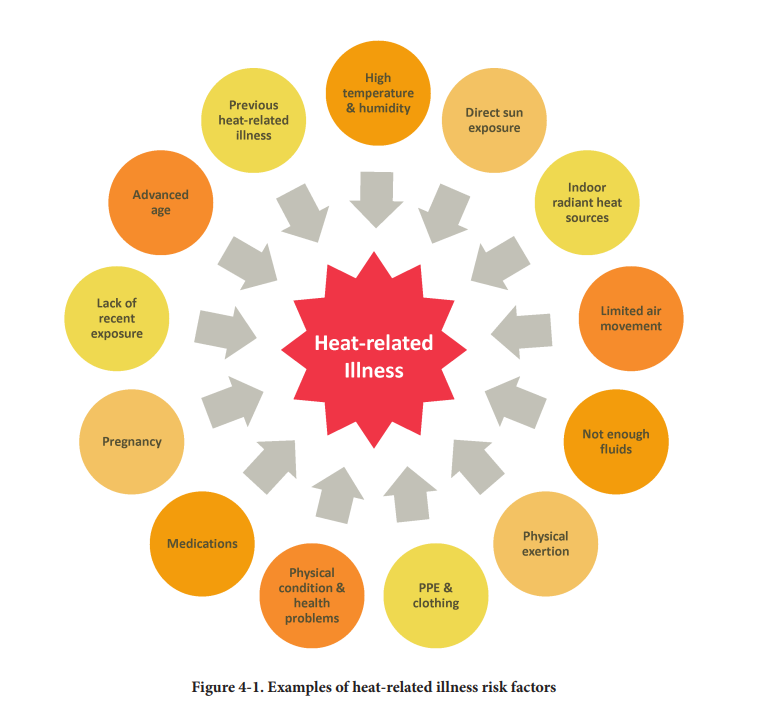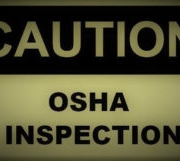Heat-related fatality cases show that workplaces with temperatures above 70 degrees Fahrenheit may have a heat hazard present when work activities are at or above a moderate workload. Assessing worker’s heat stress exposure in conditions that may present a heat hazard is critical for knowing when to implement a heat-related illness prevention program.
Although heat hazards are common in indoor and outdoor work environments, heat-related illnesses and fatalities are preventable. Many risk factors contribute to the risk of heat-related illness (see Figure below). A heat-related illness occurs when there is an increase in the worker’s core body temperature above healthy levels.

As core temperature rises, the body is less able to perform normal functions. As core temperature continues to increase, the body releases inflammatory agents associated with damage to the liver and muscles. This process may become self-sustaining and generate a run-away inflammatory response, the “systemic inflammatory response” syndrome that often leads to death.
The terms heat stress and heat strain represent the relationship and difference between external factors and the body’s core temperature control mechanisms:
Heat Stress
The net heat load to which a worker is exposed. Physical exertion, environmental factors, and clothing worn all contribute to heat stress.
Heat Strain
The body’s physiological response to heat stress (e.g., sweating).
The body’s natural way to keep the core body temperature from rising to unhealthy levels is through an increase in heart rate and sweating. When these are not enough to keep the core body temperature from rising, the result is heat-related illness or death. Elevated core body temperatures may cause the following illnesses:
Heat Stroke
Heat Stroke is the most serious heat-related illness and should be treated as a medical emergency. Heatstroke occurs when the body becomes unable to adequately dissipate heat, losing the ability to regulate core body temperature. The core body temperature rises rapidly, the sweating mechanism may fail, and the body is unable to cool down.
When heat stroke occurs, the body temperature can rise to 41oC (106°F) or higher within 10 to 15 minutes. Thinking clearly, perception, planning, and other mental processes become impaired, and the worker may be unable to recognize dangerous situations. Heatstroke can cause death or permanent disability if emergency medical treatment is not given. Symptoms include confusion, clumsiness, slurred speech, fainting/unconsciousness, hot dry skin, profuse sweating, seizures, and high body temperature.
Heat Exhaustion
Heat Exhaustion is often a precursor to heatstroke. It is often accompanied by elevated core body temperatures around 38°C–39°C (100.4°F–102.2°F). Symptoms may include headache, nausea, dizziness, fatigue, weakness, thirst, heavy sweating, irritability, and decreased urine output.
An effective heat-related illness prevention program is incorporated into a broader safety and health program and aligns with OSHA’s Recommended Practices for Safety and Health Programs core elements. Specifically, heat-related illness prevention is most effective when management commits to identifying and reducing exposure to heat stress hazards (i.e., heat hazards).
Heat Stress Prevention
The most effective way to prevent heat-related illness and fatality is to reduce heat stress in the workplace (e.g., increase air movement, reduce temperature, reduce humidity, and protect workers from solar radiation or other radiant heat sources).
The following are some engineering controls that may reduce heat stress:
- Use air conditioning
- Increase general ventilation
- Provide cooling fans
- Run local exhaust ventilation where heat is produced (e.g., laundry vents)
- Use reflective shields to block radiant heat
- Insulate hot surfaces (e.g., furnace walls)
- Stop leaking steam
- Provide shade for outdoor worksites
When engineering controls are not enough to keep worker exposure below the *AL or *TLV, administrative controls are another way to prevent a worker’s core body temperature from rising.
Some administrative controls that may reduce heat stress include:
- Acclimatize workers starting the first day working in the heat
- Re-acclimatize workers after extended absences
- Schedule work earlier or later in the day
- Use work/rest schedules
- Limit strenuous work (e.g., carrying heavy loads)
- Use relief workers when needed
When engineering and administrative controls are not enough, PPE is a way to provide supplemental protection.
PPE that can reduce heat stress exposure include:
- Fire proximity suits
- Water-cooled garments
- Air-cooled garments
- Cooling vests
- Wetted over-garments
- Sun hats
- Light-colored clothing
- Sunscreen
Conclusion
An effective heat-related illness prevention program should include a worker acclimatization program, heat alert program, and medical monitoring program. It should also establish an effective training program that includes how to recognize heat-related illness symptoms and what to do when there is a heat-related illness emergency.
OSHA recognizes that it may not always be feasible to implement all elements in all workplaces; however, implementing as many elements as possible will make the program as effective as possible.
Get more Safety Tips:
Keeping You and Your Company Safe
7 Safety Resolutions: 2020 Edition












